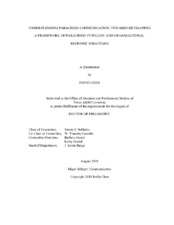| dc.contributor.advisor | Holladay, Sherry J. | |
| dc.creator | Chen, Feifei | |
| dc.date.accessioned | 2019-11-25T23:00:25Z | |
| dc.date.available | 2021-08-01T07:34:38Z | |
| dc.date.created | 2019-08 | |
| dc.date.issued | 2019-07-24 | |
| dc.date.submitted | August 2019 | |
| dc.identifier.uri | https://hdl.handle.net/1969.1/186574 | |
| dc.description.abstract | For the past few years, both academic and trade publications have repeatedly found that “social media crises” were at the core of organization fears. This dissertation argues that one of most important reasons for such fear is the prevalent use of the term “social media crisis” to refer to both crises and risks emerging from social media, which obscures the differences between risks and crises and among various types of risks that might require different organizational responses. To address this problem, Coombs and Holladay proposed the term “paracrisis” to describe more accurately crisis risks as socially constructed in social media. They also developed conceptual work on classifying paracrisis clusters and response strategies. However, extant crisis communication research and practice has largely failed to incorporate this concept. The first focus of this dissertation is thus to build on their work to refine and expand the framework of paracrisis clusters and response strategies with empirical data by collecting and 143 paracrisis cases occurring during January 2014 to December 2017 (Study 1). The other focus is to examine how might a paracrisis evolve on and off social media to gain more sophisticated understanding on how the publics communicatively construct a paracrisis and how a paracrisis differs from a full-blown crisis. To serve this focus, a big data case study using mainly computational methods has being conducted to analyze 210, 892 tweets, along with offline news coverage (Study 2).
As such, this dissertation contributes to the severely understudied paracrisis communication research by identifying typologies on paracrisis types and response strategies and gaining initial understanding to paracrisis communication processes as socially constructed on and off social media. The research findings also offer practical suggestions for social media practitioners to diagnose and strategically respond to paracrises. | en |
| dc.format.mimetype | application/pdf | |
| dc.language.iso | en | |
| dc.subject | Paracrisis | en |
| dc.subject | Paracrisis Cluster | en |
| dc.subject | Paracrisis Response Strategy | en |
| dc.subject | Crisis | en |
| dc.subject | Social Media | en |
| dc.title | UNDERSTANDING PARACRISIS COMMUNICATION: TOWARDS DEVELOPING A FRAMEWORK OF PARACRISIS TYPOLOGY AND ORGANIZATIONAL RESPONSE STRATEGIES | en |
| dc.type | Thesis | en |
| thesis.degree.department | Communication | en |
| thesis.degree.discipline | Communication | en |
| thesis.degree.grantor | Texas A&M University | en |
| thesis.degree.name | Doctor of Philosophy | en |
| thesis.degree.level | Doctoral | en |
| dc.contributor.committeeMember | Coombs, Timothy | |
| dc.contributor.committeeMember | Gastel, Barbara | |
| dc.contributor.committeeMember | Goidel, Kirby | |
| dc.type.material | text | en |
| dc.date.updated | 2019-11-25T23:00:26Z | |
| local.embargo.terms | 2021-08-01 | |
| local.etdauthor.orcid | 0000-0003-0706-1255 | |


